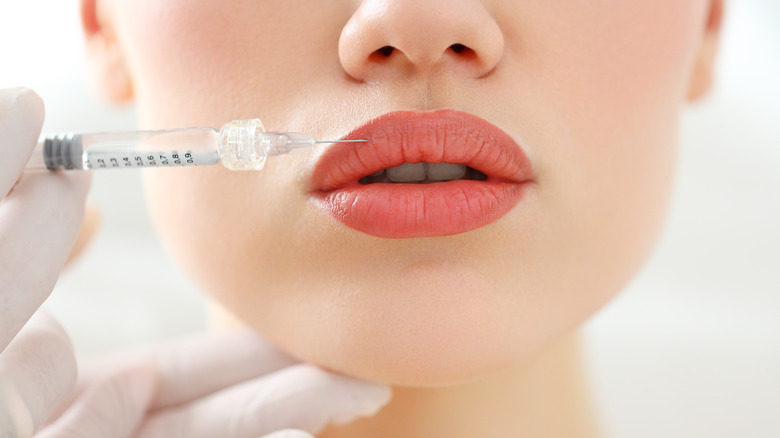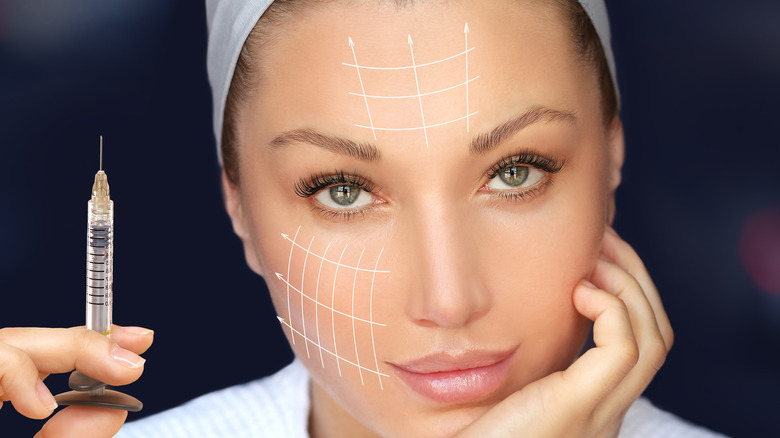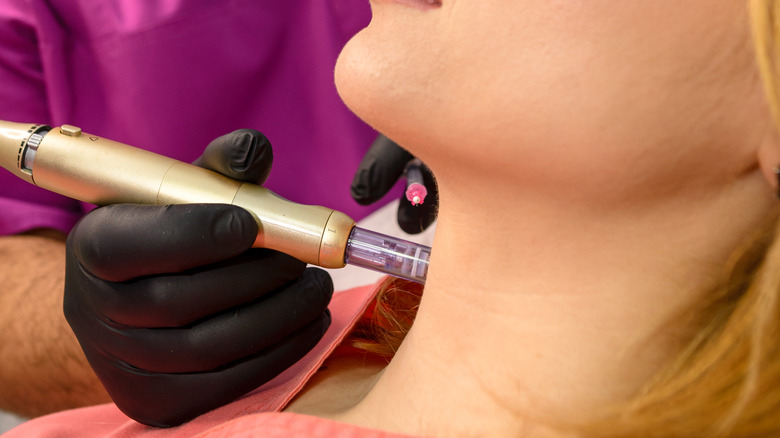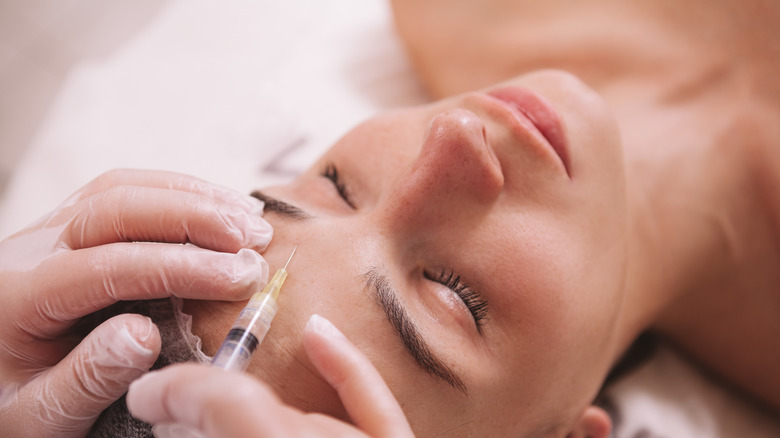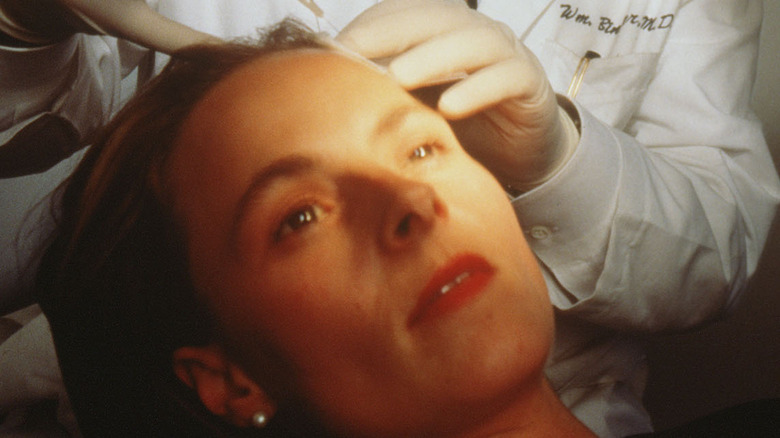What To Know Before You Get PRF Fillers
As we age, our skin loses volume as a result of the degradation of proteins such as collagen and elastin. Our tear troughs get hollow, and our face looks saggy and tired. To restore facial volume loss and keep the skin looking plump and smooth, many people turn to dermal fillers or platelet-rich plasma (PRP) injections. Both dermal fillers and PRP are injectable treatments that help rejuvenate the skin, but the ways they work are completely different. According to Ultimate Image Cosmetic Medical Center, dermal fillers work by plumping the skin with a hyaluronic acid solution, while PRP — also known as a vampire facial — uses your own blood platelets to boost collagen production at cellular levels and regenerate the skin. Kim Kardashian and Angelina Jolie are celebrities who have turned to PRP to limit signs of aging and keep their skin looking youthful.
Now that you've familiarized yourselves with the concepts of fillers and PRP, let's get to know platelet-rich fibrin (PRF), a skin rejuvenation treatment that has been growing in demand lately. Like PRP, PRF is also an injectable treatment that involves employing your own blood cells to promote the health of your skin, per Deschutes Dermatology. However, PRF is considered the second generation of PRP and is superior to the traditional vampire facial in certain ways. If you're looking to incorporate something new into your bimonthly spa special treatments, look no further than a PRF injection. Here's what to know before you go for PRF injections.
How a PRF facial works
When you get a PRF treatment, a healthcare professional will first draw your blood into a tube, and the number of tubes depends on the amount of surface area you want to cover, according to Aesthetics MedSpa. Then, the tubes containing your own blood are spun in a centrifuge to separate the blood into layers containing the different components, such as white blood cells, red blood cells, plasma, and platelets. When the centrifugation is complete, the layer with the PRF components — containing white blood cells, fibrin, platelets, and stem cells — is extracted. After that, the platelet-rich fibrin mesh harvested from the centrifugation is immediately injected into the areas that need treatment, and growth factors are slowly released into the targeted areas over time.
This centrifuging process may call to mind PRP, but PRF and PRP are very different. Aesthetic and functional medicine physician Azza Halim points out to Shape that PRF is spun in the centrifuge at lower speeds and for a shorter period of time than PRP in order to gather more growth factors. Collagen and elastin — the two proteins essential for plump and elastic skin — are stimulated by those growth factors. Unlike PRP, PRF also contains no anticoagulants and is 100% natural, says Dr. Halim. Price-wise, the cost of PRF injections varies from location to location, but you can expect to pay anywhere from $500 to $2000 for each session.
PRF can improve skin quality in the long run
PRF is a non-invasive method used to promote your own collagen growth, enhance skin tone, tighten crepey skin, and diminish the appearance of aging lines and folds, according to Dr. K Beauty in LV. Face aside, PRF can also be used to regenerate the scalp and restore the inactive hair follicle, helping to reverse hair loss in the early stage. Another great thing about PRF is that there will be few to minimal allergic reactions or infections following the procedure — since the injected materials are obtained from your blood, your body will not consider them to be foreign materials that should be rejected.
Mild pain, puffiness, and moderate bruising are typically the only side effects of PRF, but they usually go away three to five days after injection, according to Pure Dermatology. While PRF is generally safe for most people, those with hemophilia or blood clotting problems, as well as those using medications that might interfere with their platelets, should consult their physicians to see if they're the right candidate for the procedure.
PRF versus dermal fillers and PRP
Compared to standard dermal fillers, PRF takes longer to show results, according to New Life Aesthetics. Dermal fillers swiftly add volume to your skin by injecting a chemical composition, and the effects are visible almost immediately. Meanwhile, PRF uses a product derived from your blood components to help your body regenerate healthy tissues, improving the texture and tone of the skin naturally. Typically, PRF consists of a series of treatments spaced out six to eight weeks apart. Long-term advantages, such as increased collagen production, smoother skin, and a more radiant complexion, usually manifest within three to four months and last for six to 12 months. The best results from PRF are often seen a year or more after the initial treatment.
Compared to PRP, PRF is a better alternative long-term. Not only does it benefit the skin in the same way that PRP does, but it also releases more growth factors into the skin over time, allowing them to continue working for your skin even after the procedure is done, according to Advanced Cosmetic Dentistry. In a nutshell, PRF is a great option for those seeking long-term, natural rejuvenation of the skin, or those who have experienced side effects from fillers.
PRF cannot replace dermal fillers
PRF might be the next most sought-after all-natural solution for skin rejuvenation, but it cannot replace standard fillers, especially when treating darkened under-eye areas or hollowed cheeks. "The reality is they don't really create a volume change there," facial plastic surgeon Dr. Amir Karam tells Byrdie. Dr. Karam goes on to add that PRF injections will not be of much help when it comes to adding volume to the under eyes or places where fillers are normally needed. Therefore, PRF isn't a viable solution for compensating for volume loss in the skin. If you want to address facial volume loss effectively, dermal fillers are still the best bet.
Another thing to keep in mind is that PRF requires five appointments to see results, according to Glamour's writer Lindsey Ellefson who went for PRF fillers. With dermal fillers, you only need one appointment to start seeing results. With PRF, having blood coming out and back into your face five times within a year can inflict considerable bruising and trauma to your face. And what you get in return may appear to be mild to unsatisfactory changes that might take up to a year to manifest. In a nutshell, PRF can enhance your skin in the long run, but it's by no means a filler replacement. To amplify PRF results, consult your dermatologist or surgeon on how to use PRF with other anti-aging treatments such as microneedling or dermal fillers.
